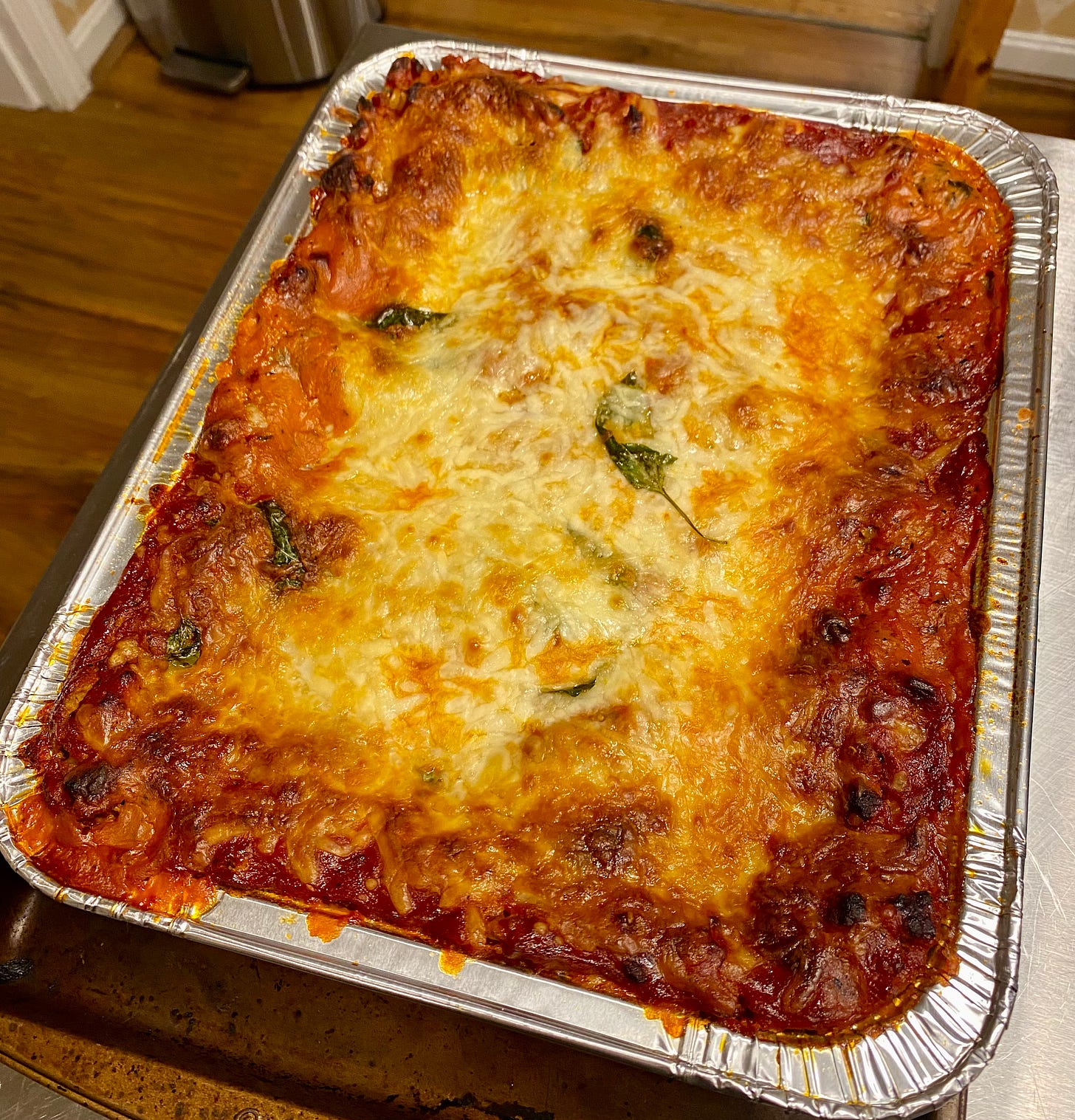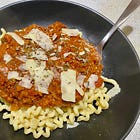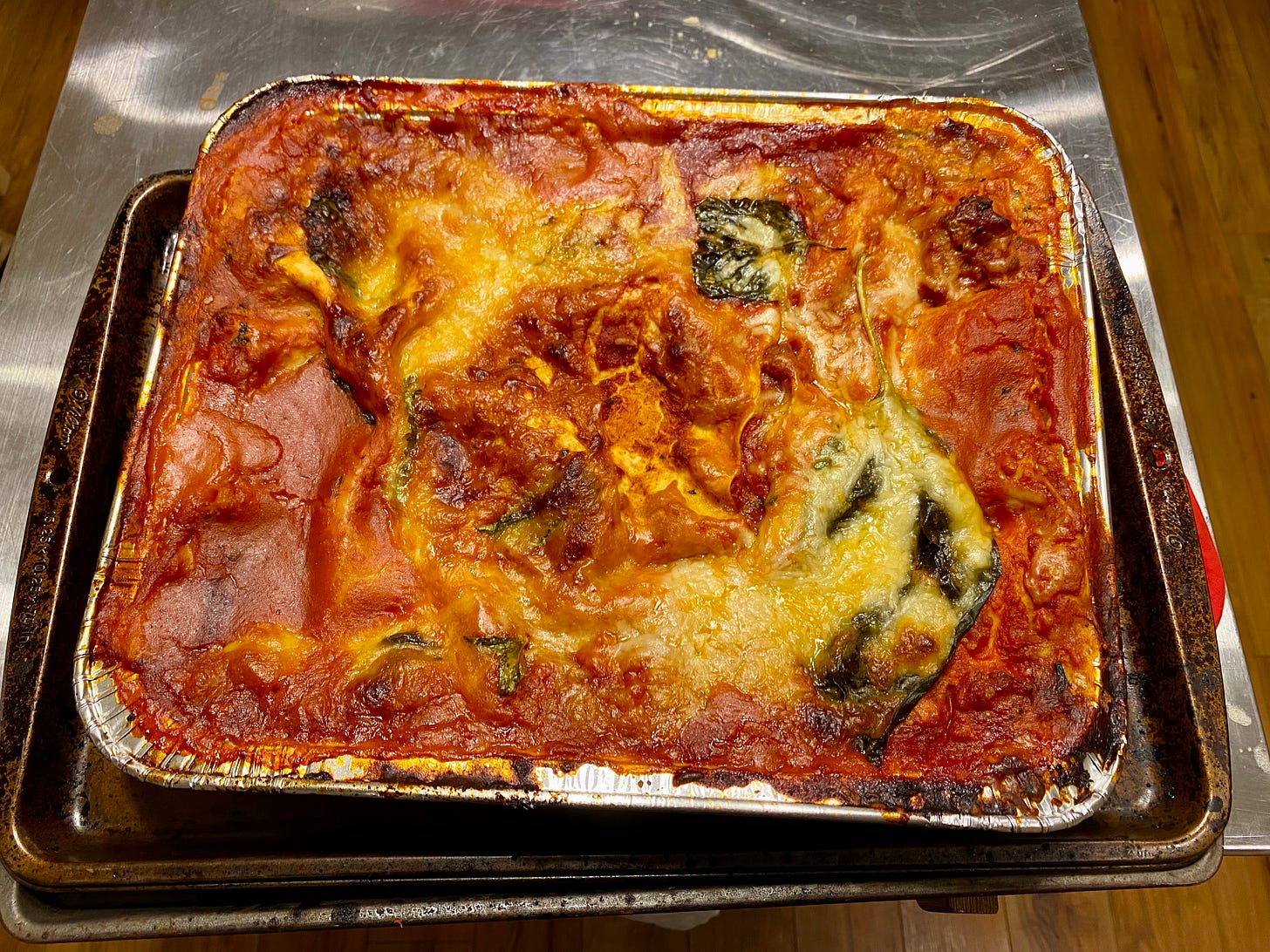The Fewdsletter: 'Do Something' Lasagna
How to make cheesy comfort for yourself — and a neighbor
A few months ago I started volunteering for Lasagna Love, a nonprofit group that pairs people in need of comfort food with nearby home chefs who can deliver it. Lasagna is the archetypal meal to bring someone who’s going through a tough time, and for good reason — it’s warming, it’s hearty, and the effort it takes to assemble one is proof that the cook really cares about whoever’s eating it. As a homebody without a consistent schedule who was looking for a way to give back, I found it to be an extremely rewarding way to do some direct good for my community. (I say this not to be self-aggrandizing but to emphasize how easy it is to get involved.)
There was just one catch: I had never made a lasagna before.
Dozens of deliveries later, suffice to say I’ve figured it out. I can’t tell you that my version is particularly novel or better than your nonna’s, but it’s at least pretty good and it’s surprisingly easy to make. I started with the recipe from Lasagna Love founder Rhiannon Menn and gradually added my own twists, including inspirations from a spinach-and-ricotta pasta that my mom frequently makes, and the signature sweet sausage and basil under the cheese from The Sopranos’ infamous “Carmela’s lasagna.”
I firmly believe that the best lasagna is the one you actually make, which means taking shortcuts that I normally wouldn’t include in a public-facing recipe, but have enabled me to turn making multiple deliveries a week into a routine. (This is why I haven’t had much time for writing lately.) I wish I could always use my homemade meat sauce in my lasagne, but that would inflate the pre-bake prep time from 20 minutes to several hours, and the store-brand sauce that costs less than $3 for the jumbo bottle is pretty decent. Pre-shredded mozzarella melts almost as well as if you had cut it up yourself. And with apologies to any Italians reading this, jarred parmesan works just fine as the tertiary cheese flavor in the dish. The trick is jazzing it up with other thoughtful but simpler touches, like infusing spinach and parmesan into the ricotta and tucking basil leaves under the bubbling mozzarella, so it still tastes unmistakably homemade.
I’m calling this recipe “Do Something” Lasagna, because the phrase has been a key motivation for my volunteer work in multiple ways:
In a time when so many people are struggling, bringing a hot meal to a neighbor is a simple way to do something to lend a hand and build community.
Making and delivering lasagna gives you a chance to do something besides staring at your phone and doomscrolling.
When you beg your elected officials to please, for the love of all that is decent, do something to obstruct the ongoing assault on constitutional rights, civil liberties, and basic principles of good governance, you can say with a straight face that are you are doing more to better the world than they are.
The recipe below is doubled by default, so it makes two lasagne: one for you, and one for someone else who could use a hot meal, whether as part of an organized process or because you know your neighbor could really use one. Or you can work efficiently and make two to donate at a time! At the risk of sounding preachy, volunteering for Lasagna Love is far and away the best thing I have done over the last few months, both in terms of doing good and as an outlet for my own shock and despair. I hope you enjoy the recipe either way, though if you have the wherewithal to do so it would warm my heart to learn that some Lewsletter readers were moved to sign up too.
As an added bonus, if you volunteer regularly, you’ll also become the kind of person who can whip up a lasagna from mere muscle memory, which is a very cool and useful life skill to have. Like when you’re trying to figure out what to bring to an Oscars party, and you have a last-minute vision to make a “Lasagn-al Gaib.” (I made everyone acknowledge the pun before they could have any.)
“Do Something” Lasagna
This approachable take on the Italian classic will provide cheesy comfort for your family — and someone else’s. Makes two half-tray pans of lasagna, enough to serve 15 to 20 people.
Ingredients
1 pound sweet Italian sausage (no casings)
1 pound lean ground turkey
2 large (45 oz) jars tomato sauce
1 cup water
2 pounds ricotta cheese
1 pound frozen spinach, thawed and drained
2 cups grated parmesan
2 boxes no-boil lasagna noodles (you may not use them all, depending on the size and shape)
2 pounds shredded mozzarella cheese
A handful of fresh basil leaves, washed
Steps
Heat a deep skillet or heavy-bottomed saucepan over medium-high. Add sausage and cook, stirring frequently and crumbling the meat into small pieces. Once meat is browned and cooked through, scoop it into a bowl with a slotted spoon, leaving a little bit of rendered fat in the pot.
Using the same pot, add the turkey and cook, stirring frequently and crumbling the meat as finely as possible, until meat is browned and cooked through.
Return the cooked sausage to the pot and add tomato sauce. Pour a 1/2 cup water into each empty sauce jar, shake to loosen the remaining sauce, and add into the pot. (The extra water helps the noodles cook.) Reduce heat to low and cook, stirring occasionally, until the sauce starts to simmer.
In a large bowl, combine ricotta, spinach, and parmesan until well mixed.
In two deep half-tray (12" x 10" inches) pans, layer the ingredients in the following order:
1/4 of the sauce (about 2 cups per pan)
A layer of pasta (probably 3 noodles per pan, depending on the size and shape)
1/2 of the ricotta mixture (about 2 cups per pan)
1/4 of the mozzarella (about 1 cup per pan)
Another 1/4 of the sauce
Another layer of noodles
The rest of the ricotta mixture
Another 1/4 of mozzarella
Another 1/4 of the sauce
Another layer of noodles
The rest of the sauce
The basil
The rest of the mozzarella (this layer is thicker than the previous ones)
Tent with foil and bake at 375º F for 30 minutes.
Remove foil and bake for another 30-40 minutes, or until cheese is golden brown and bubbly. (When you the sight of the cheese bubbles makes you gasp involuntarily, it’s done.)
Additional Tips
Crumble the meat as finely as you can, as the chunks may make it hard to assemble the layers later. (This is why I use only one pound of meat per pan.)
You can prepare the sauce the day before and keep it refrigerated until you’re ready to assemble the lasagna. If you have quart-sized takeout containers lying around, store the sauce in those and it will be pre-portioned for assembly — one container equals one layer (half a carton per pan).
Place large baking sheets under the trays to prevent sauce and cheese spilling inside your oven.
Most of the ingredients are shelf-stable or freezable, so if making lasagna becomes a habit, you can save a lot of money by buying supplies in bulk at a wholesale club or when they are on sale. These ingredients would cost somewhere between $25 and $30 per lasagna if I bought them in single-pan increments at a single supermarket, but I spend only about $20 per lasagna by buying a few trays’ worth at a time where I’ve found the prices are cheapest. (God bless Market Basket.)
For Dietary Restrictions
The joys of comfort food ought not be bound by allergies or dietary preferences. I’m not a nutritionist, but I take pride in making lasagna as inclusive as possible for the folks I deliver to. Here are some of the tricks I’ve learned from helping people navigate their food restrictions:
Gluten-free: Use gluten-free noodles or replace pasta with thin-sliced eggplant or zucchini.
Lower carbohydrates: Use whole wheat or gluten-free noodles, or replace some or all pasta layers with thin-sliced eggplant or zucchini. You can also look for no-sugar-added sauce or replace it with plain canned crushed or diced tomatoes.
Lower cholesterol: Replace the sausage with additional lean ground turkey, reduce or omit the ricotta, and omit the lower layers of mozzarella (or reduce the cheese and augment with grated squash).
Lower salt: Replace the sausage with additional turkey or other unseasoned ground meat, and reduce or omit the parmesan. You can also look for no-salt-added sauce or replace it with plain canned crushed or diced tomatoes.
Vegetarian: Omit the sausage and turkey, or replace them with sautéed mushrooms or crumbled plant-based meat substitute. You can also compensate for the protein with some extra ricotta.







I suggest we call it Lew-sagna